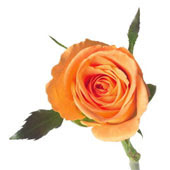 Roses, popularly known as the queen of flowers look beautiful and spread fragrance in any garden. This regal flowering shrub valued mainly for the colour and fragrance of their flowers, has about 150 species.
Roses, popularly known as the queen of flowers look beautiful and spread fragrance in any garden. This regal flowering shrub valued mainly for the colour and fragrance of their flowers, has about 150 species.Many thousands of cultivars have been developed from these species through cross breeding, selection and hybridization and they vary widely from miniatures under a foot tall to climbing types that climb up to 50 feet.
Roses considered as the flowers of love has inspired artists, writers and composers for centuries. It was the Greek poet Sappho who coined the title 'Queen' to the flower over 2500 years ago. In the early Roman culture, Roses were a part of upper class life.
 The decorations for parties, weddings, funerals, festivals and on statues and monuments, chariots and shields were adorned with roses. People would bathe in rose water, wear rose garlands, make confections and wine with rose petals.
The decorations for parties, weddings, funerals, festivals and on statues and monuments, chariots and shields were adorned with roses. People would bathe in rose water, wear rose garlands, make confections and wine with rose petals.Even medications were prepared from rose petals, fruits (hips) and seeds. The most important rose collection of the early 19th century was Of Empress Josephine, wife of Napoleon 1 of France, in her famous garden at the imperial chateau Malmaison with over 250 varieties of roses.
The flower had significance as a symbol in the early Christian Church. The 'rosary' of the Christians originated from the Latin word 'rosarium' meaning rose garden. The cultivars can be divided into Old Garden and Modern roses and these into several well recognized sub groups.
In a garden, roses can be planted as borders, hedges, backgrounds, specimen plants- in short, in virtually any role that other shrubs can play. They can be planted not only in the open ground but in containers and raised beds on your verandah, terrace or balcony.
If planted in the right way you can enjoy watching your roses bloom year after year.






